Pythons and Anacondas are some of the largest snakes in the world today, but what about prehistoric snakes?
Has anyone ever found fossils of snakes from long ago? How big do you think “dinosaur snakes” would have been?
Scientists can take fossils and piece them together to figure out clues from the past. Let’s learn about the largest snake fossil ever found!
What is the largest snake in the world today?
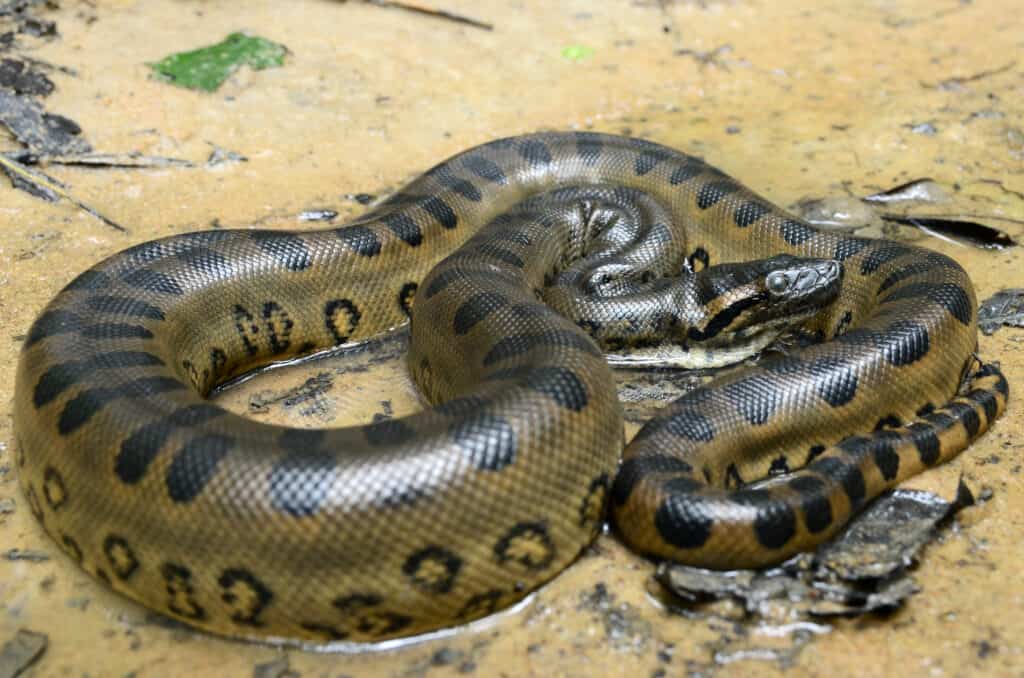
The Green Anaconda is the largest snake alive today. Some have been measured at more than 500 pounds!
©Patrick K. Campbell/Shutterstock.com
The largest snake in the world is the Green Anaconda (that is, the largest living snake). Prehistoric snakes are thought to be much larger.
Green anacondas can get to be 18-20 feet long and weigh 300-400 pounds although some have been recorded to be larger. They are thick-bodied snakes that can reach 12 inches in diameter, you wouldn’t be able to grasp your hands around them in some parts.
Where Does the Green Anaconda Live?
The Green Anaconda is a large and powerful snake that is found in the tropical rainforests of South America. Specifically, the Green Anaconda is native to the Amazon Basin, which covers parts of Brazil, Bolivia, Colombia, Ecuador, French Guiana, Guyana, Peru, Suriname, and Venezuela.
Within this range, Green Anacondas can be found in a variety of aquatic habitats, including rivers, streams, swamps, and marshes. They are most commonly found in slow-moving rivers and streams that are lined with vegetation, as well as in flooded forests and wetlands.
Green Anacondas are known for their size, with adult females growing up to 15 feet (4.5 meters) in length and weighing over 200 pounds (90 kilograms). Males are generally smaller, reaching lengths of up to 9 feet (2.7 meters) and weighing around 50 pounds (23 kilograms).
Despite their formidable size, Green Anacondas are generally docile and non-aggressive toward humans and are more likely to retreat or hide when confronted. However, they are apex predators in their ecosystem and play an important role in the food chain, preying on a variety of animals, including fish, birds, reptiles, and mammals.
What is the longest snake in the world?
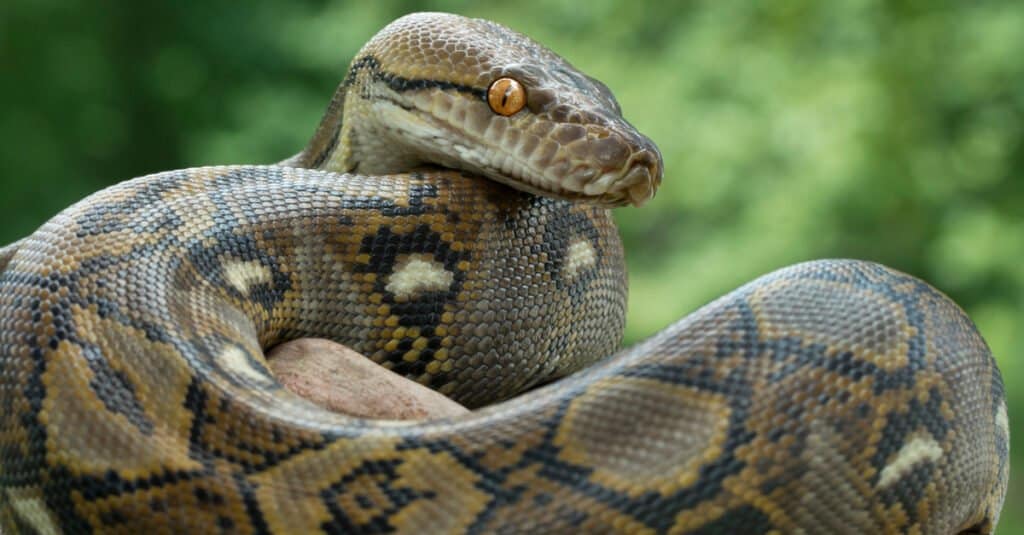
The longest snake in the world is the Reticulated Python, with some getting longer than 25 feet.
©Mark_Kostich/Shutterstock.com
The longest-living snake in the world is the Reticulated python which can get to 15-20 feet with some getting more than 25 feet. They are heavy-bodied snakes but not as bulky as the anacondas. An average reticulated python can weigh up to 250 pounds.
What is the heaviest snake on record?
According to the Guinness World Records, the heaviest snake on record was a 500-pound anaconda shot in 1960 in Brazil. The snake measured 27 feet 9 inches, had a 44-inch girth, and was 500 pounds. Since then, reports of larger snakes have occurred such as an Anaconda reported to be about 33 feet and more than 800 pounds.
However, verifying these reports which often happen in remote areas is difficult.
What is the largest snake fossil ever found?
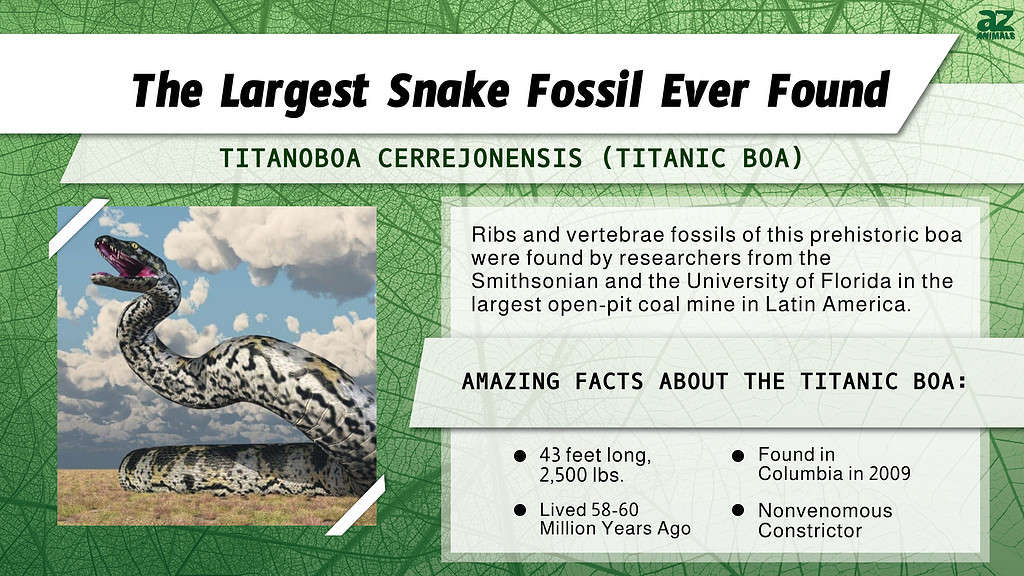
The largest snake fossil ever found was discovered by a group of scientists in northern Colombia in 2009. They found fossils from the Titanoboa cerrejonensis, which means Titanic Boa. Based on the size of the fossils scientists think the largest snake was 43 feet long and weighed 2,500 pounds! Can you imagine?
In comparison, the largest school buses are 45 feet long, so that is one big snake! For a snake that long to reach 2,500 pounds, it is not a skinny garden-hose-shaped snake. It had to be a thick-bodied massive snake!
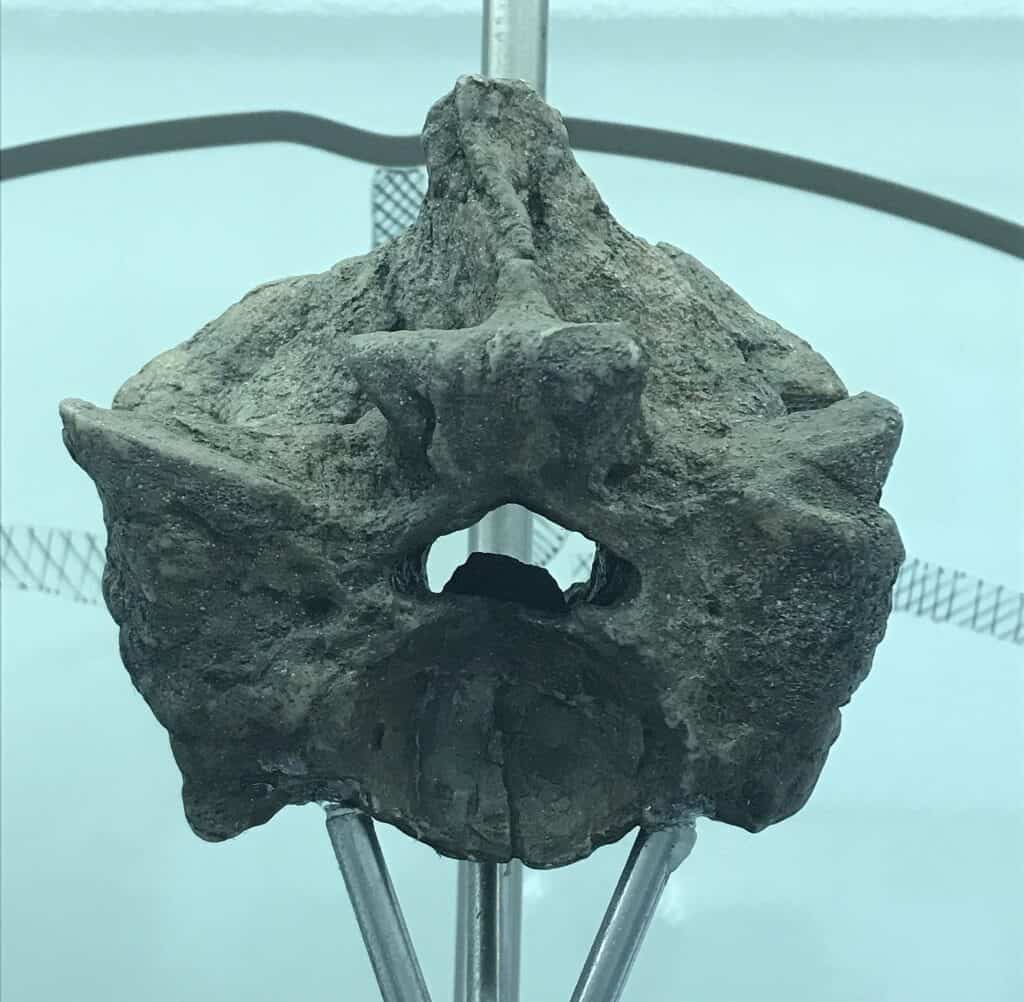
The largest snake skeleton ever found was a
Titanoboavertebra discovered in Colombia.
Where did scientists find the largest snake fossil ever found?
The scientists found the fossils at the Cerrejon Coal Mine, the largest open-cast coal mine in Latin America. It is located in the department of La Guajira in Colombia, which is in northern Colombia.
Who found the largest snake fossil ever found?
The two primary scientists were geologist Carlos Jaramillo from the Smithsonian Tropical Research Institute and vertebrate paleontologist Jonathan Bloch from the University of Florida. The lead author of the research article was the University of Toronto’s Paleontologist Jason Head.
What do we know about Titanoboa cerrejonensis, the largest snake ever to have existed?

Scientists have discovered parts of the snake’s backbone and skull, which helped them estimate the snake’s massive size.
©Michael Rosskothen/Shutterstock.com
Titanoboa cerrejonensis(Titanic boa) was thought to be a boine snake similar to anacondas and boas of today. They were non-venomous constrictor snakes. The area that is now northern Colombia was thought to be a tropical rainforest as well back in prehistoric times.
How long ago did these giant snakes live?
Scientists think the fossils date back to 58 million to 60 million years ago. This was after the mass extinction that wiped out dinosaurs 65 million ago.
What kinds of fossils were recovered?
The scientists found vertebrae and ribs from the largest snake fossils ever found. Snakes of today have between 100-450 vertebrae in their bodies and another 10-200 in the tail section. Snakes are considered vertebrates due to their backbone structure that is moved by muscles.
There were no skull or teeth fossils recovered at this dig site, but artists were able to sketch an idea of what they thought these mammoth snakes would have looked like.
How does the Titanoboa cerrejonensis compare in size to a human?

This sketch shows how large a Titanoboa would be compared to a human!
©Michael Rosskothen/Shutterstock.com
If there were Titanic Boas around today they would be as long as a school bus and weigh almost as much as a small car. A geologist from Indiana University, David Polly, gave this description of the Titanic Boa, “At its greatest width, the snake would have come up to about your hips.”. Can you even imagine standing next to a snake that came up to your hips? Wow!
Why were prehistoric snakes so much bigger than snakes now?
When you think about dinosaurs and prehistoric animals they all seem to be bigger than the animals that live on Earth now. Why would that be? Scientists are looking into the temperature of the earth during prehistoric times as one of the major factors that contributed to animals being able to grow larger and heavier.
Snakes are cold-blooded animals so they are influenced by the temperature in their environment. This is why there are no snakes in Alaska! (Did you know that?). Researchers have found a correlation between the average temperature and the size of cold-blooded animals.
Think about the large green anacondas and the tropical climates they live in South America. You are not going to find any 20-foot snakes in Canada!
If global warming continues could snakes grow to be 43 feet long like the Titanic Boas?
Well, technically yes. Is it likely? Probably not. Scientists estimate the temperatures would need to be at least 5 degrees warmer over a consistent period of time. In the climate world, 5 degrees is a huge amount.
What other giant creature roamed the earth millions of years ago?

Prehistoric crocodiles would have been large enough to take on a T-Rex…and win!
©Elenarts/Shutterstock.com
Another cold-blooded animal that we have found fossil evidence of is the crocodile. Just recently in British Columbia tracks and traces of ancient crocodiles have been found. The tracks are estimated to be 95-97 million years ago. By measuring the distance between the tracks scientists can estimate the size of the crocodiles.
The ones they found were estimated to be 29-39 feet long and weigh around 5 tons! The largest crocodiles today, Saltwater Crocodiles, are around 15-17 feet in length and weigh more than 2,000 pounds.
Could there be larger snake fossils yet to be found?
Absolutely! Paleontologists and scientists continue to search for fossils of ancient reptiles and dinosaurs to better understand the history of these creatures. A 43-foot-long snake seems to be pushing the limits of the animal but who knows, maybe larger snakes did exist!
What causes snakes to go extinct?
Causes of extinction include habitat loss, habitat fragmentation, poaching, and climate change. All around the world, there are hundreds of species of endangered snakes we should act to save.
Many of these snakes only occur in tiny, restricted habitats, making them vulnerable to extinction.
Other Record-Breaking Snakes
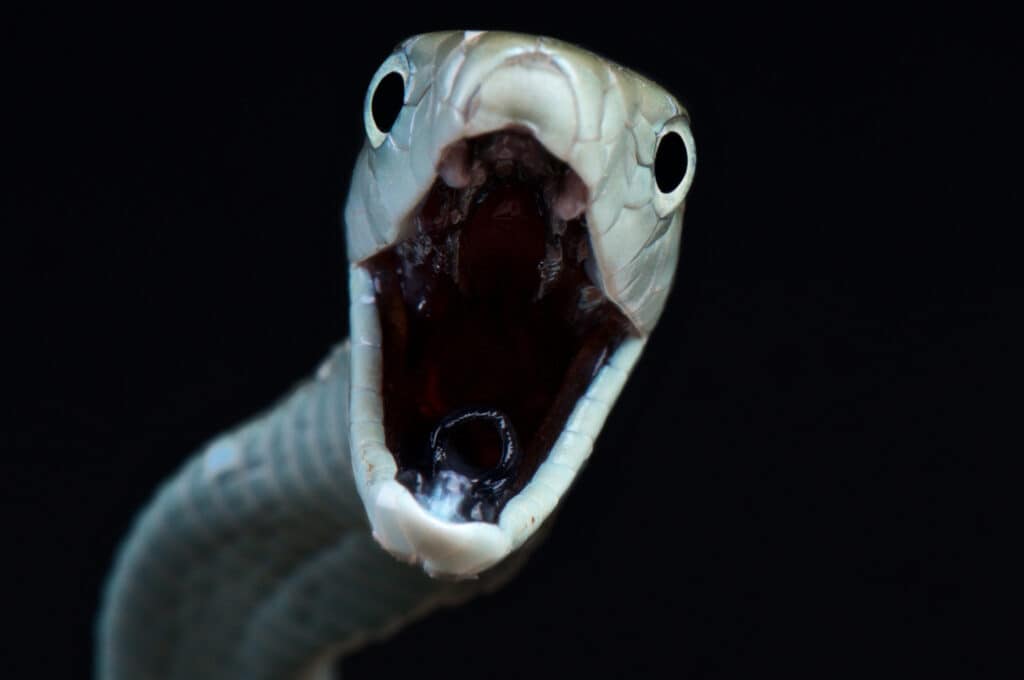
The black mamba is one of the most venomous snakes in the world and is feared for its large size and aggressive behavior.
©reptiles4all/Shutterstock.com
If global warming continues and snakes grow larger as they did millions of years ago – how would we survive the amazing colossal-sized version of a deadly black mamba? They are big and fierce as they are now – not to mention deadly. Black mambas are one of the most venomous snakes in the world and can grow over 12 feet in length and move at speeds of up to 12.5 mph.
Native to Africa, the black mamba is actually seldom black. Their colors range from yellow-brown, light tan, olive, and gunmetal grey which can reflect a purple hue. Their open mouths reveal a terrifying black cavernous void and an inky flicking tongue. Black mambas will hiss loudly and spread its neck into a hood before it stands like a cobra and unleashes a series of strikes – not one and run – several potentially deadly strikes. Whenever this snake hunts – it waits on the venom to paralyze its victim and then swallows the animal whole.
So, how long is the largest black mamba? It’s over 14 feet in length! Read the next post to find out exactly how large – and then ponder the possible existence of a monster mamba in a world where global warming reaches the point of no return.
The photo featured at the top of this post is © Michael Rosskothen/Shutterstock.com
Discover the "Monster" Snake 5X Bigger than an Anaconda
Every day A-Z Animals sends out some of the most incredible facts in the world from our free newsletter. Want to discover the 10 most beautiful snakes in the world, a "snake island" where you're never more than 3 feet from danger, or a "monster" snake 5X larger than an anaconda? Then sign up right now and you'll start receiving our daily newsletter absolutely free.
Thank you for reading! Have some feedback for us? Contact the AZ Animals editorial team.






